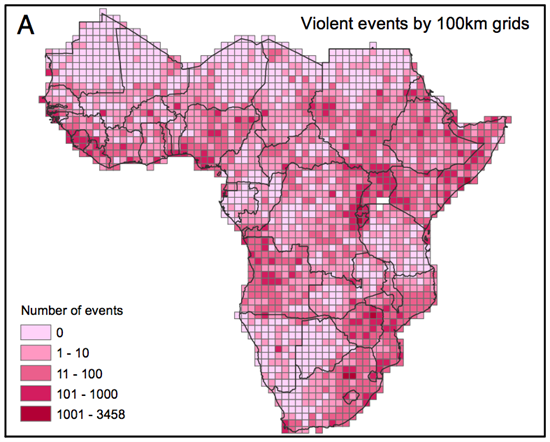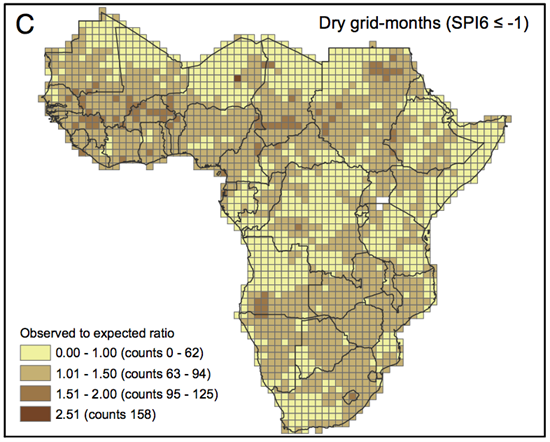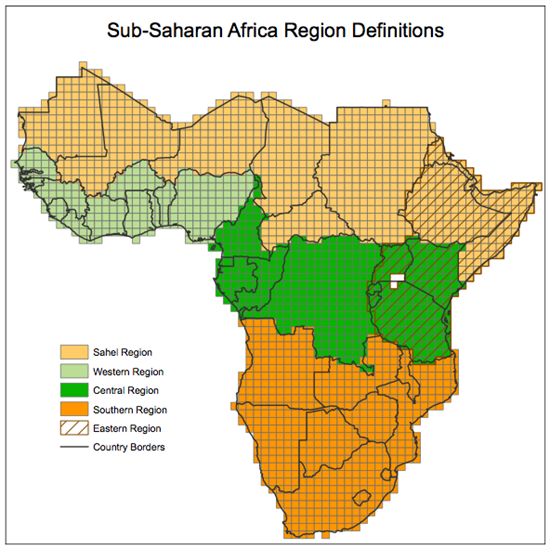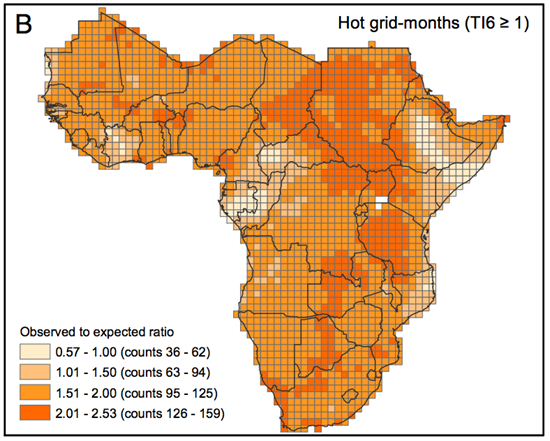Robert McSweeney
10.11.2014 | 8:57pmAnalysis of violent events in the past 30 years in sub-Saharan Africa reveals a link to high temperatures, a new study finds.
However, the researchers say the impact of climate is less important than many other social and economic factors.
Heated debate
The relationship between climate change and conflict has prompted much heated debate among academics. A recent review of 50 studies found they consistently supported the theory that changes in climate can cause conflict, but the conclusion was roundly criticised by a group of 26 other researchers.
On the face of it, the connections might seem obvious. Climate change risks exacerbating competition for natural resources, causing displacement through climate extremes and natural disasters, or just making it harder for governments to manage existing problems.
Yet there is limited evidence of a direct link, partly because there are so many political, social and economic factors involved in conflict. In its recent synthesis report, the IPCC says there is “medium confidence” that climate change can indirectly increase risks of violent conflict by amplifying poverty and economic shocks.
These other factors are considered alongside climate in a new study published in Proceedings of the National Academy of Sciences, which analyses high temperature extremes and violent events in sub-Saharan Africa.
Violent events
The study uses temperature and rainfall data alongside a dataset of armed conflict events from civil wars and periods of instability, for the period 1980 to 2012. The maps below show this data plotted as 100km grid squares across sub-Saharan Africa.
On Map A, the dark pink areas show where the highest number of violent events have occurred in recent decades. For example, the borders between the Democratic Republic of Congo and Rwanda and Burundi show a large patch of dark pink, as does much of Zimbabwe, and Somalia on the westernmost point of Africa.

Map showing number of violent events in sub-Saharan Africa between 1980 and 2012. O’Loughlin et al. (2014).
Maps B and C show how the number of ‘hot’ and ‘dry’ months compares with the long-term average. You can see that much of central and eastern Africa has been warmer than usual, while southern areas and the Sahel have been drier than expected.

Maps showing B) number of ‘hot’ months, and C) number of ‘dry’ months for sub-Saharan Africa between 1980 and 2012. Maps B and C show data as a ratio compared to the expected number of ‘hot’ and ‘dry’ months from the long-term average. In all maps, the darker colours show the areas affected more severely. O’Loughlin et al. (2014).
The Sahel
The researchers combined the climate and conflict datasets to see if they could find any relationships between them. Their results show a 10 per cent increase in violent conflicts with every one standard deviation increase of temperature, but no link with high or low precipitation.
In other words, the researchers found there were more conflicts when it was hotter. However, they couldn’t tell whether heat caused the conflicts or if the two were linked by other factors.
Further analysis looking at five specific regions of sub-Saharan Africa (see map below) reveal that the temperature relationship is only statistically significant for the Sahel. The researchers think this strong link was the reason they found the continent-wide relationship in the first instance.

Regional definitions for sub-Saharan Africa. O’Loughlin et al. (2014).
The results also show that the type of conflict linked to higher temperatures is primarily against civilians. The researchers suggest this could be because responses to extreme weather are immediate rather than long-term, making it more likely to be small-scale conflicts such as land seizures or cattle-raiding than organised warfare.
Predicting conflict
The study also looks at whether they could use temperature extremes in a model to predict violent events.
The researchers find that the climate is less important than a number of political, social and economic factors for predicting conflict. Factors considered more important include existing conflict in neighbouring areas, socio-economic well-being, distance to national borders, and capital city location.
Alex Randall, project manager of the Climate Change and Migration Coalition, explains the significance of the findings:
Halvard Buhaug, a research professor at the Peace Research Institute in Oslo (PRIO), says the research is a step forward:
O'Loughlin, J. et al. (2014) Effects of temperature and precipitation variability on the risk of violence in sub-Saharan Africa, Proceedings of the National Academy of Sciences, http://www.pnas.org/cgi/doi/10.1073/pnas.1411899111


